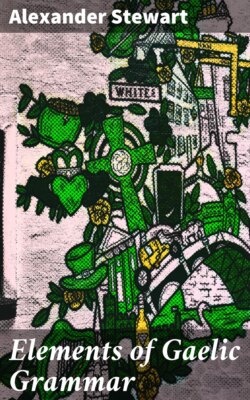Читать книгу Elements of Gaelic Grammar - Alexander Stewart - Страница 40
На сайте Литреса книга снята с продажи.
S.
ОглавлениеTable of Contents
1. Plain. Broad: like s in sun, this; as, speal a scythe, cas a foot, sùil an eye, scian a knife.
2. Small: like sh in show, rash; as, bris to break, sèimh quiet, sniomh to twine, stéidh foundation.
3. Aspirated: like h in him; as, shuidh sat, shrann snorted. Before l and n, it is almost, if not altogether, quiescent; as, shlanuich healed, shniomh twisted. S followed by a mute consonant is never aspirated.
RULE.—S has its SMALL sound, when, in the same syllable, it is preceded or followed by a SMALL VOWEL, with or without an intervening Lingual. In all other situations it has its BROAD sound. Except. S is broad in is am. It is small in so this, sud yon. It is customary to give s its broad sound in the beginning of a word, when the former word ends with r, in which case the r also has its broad sound; as, chuir sinn we put, air son on account.
Of L, N, R.
A distinction between a consonant when plain, and the same consonant when aspirated, has been easily traced thus far. This distinction readily discovers itself, not only in the pronunciation and orthography, but also (as will be seen in its proper place) throughout the system of inflection. It takes place uniformly in those consonants which have been already considered. With respect to the remaining linguals, l, n, r, a corresponding distinction will be found to take place in their pronunciation, and likewise in the changes they suffer by inflection. This close correspondence between the changes incident to l, n, r, and the changes which the other consonants undergo, seems to be a sufficient reason for still using the same discriminative terms in treating of their powers, though these terms may not appear to be so strictly applicable to these three consonants as to the rest. The powers of l, n, r, shall accordingly be explained under the divisions plain and aspirated, broad and small.
